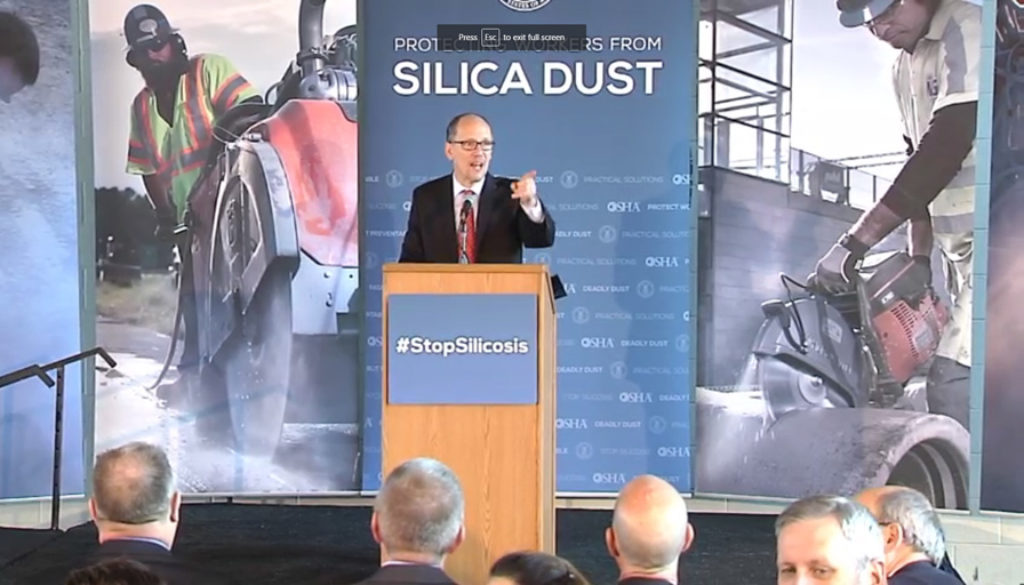Finally, a Silica Rule: A Story of Industry Interference and Regulatory Delay
By Gretchen Goldman, Union of Concerned Scientists
“The science is clear,” Representative Frederica Wilson asserted in a Congressional hearing on silica earlier today. Last month, the Department of Labor issued the long-awaited silica rule to protect workers from health effects of crystalline silica dust exposure. The rule is long overdue in light of the department’s inadequate and outdated 1971 silica standard. The new rule should be celebrated; it has now caught up to science and when fully implemented, it will save more than 600 lives per year and have a net benefit of $7.7 billion annually. But we also need to take a deeper look at why something that made so much sense has taken so long to be implemented and why it’s still under attack.

Last month, the Department of Labor issued their long-awaited rule to protect workers from harmful silica dust. The rule is expected to save more than 600 lives and save $7.7 billion annually.
Silicosis and the costly impacts of silica exposure
Scientists have known for decades about the health effects of silica dust exposure, including silicosis, an irreversible and debilitating lung disease that can cause respiratory failure among other problems. Silica is widely used in the construction, food, pharmaceutical, and many other industries, and silicosis occurs when workers inhale the respirable crystalline silica dust that can get into the air.
Remarkably, none of this is new science. Back in the 1930s, the construction industry was conducting studies on exposure of workers to silica dust and the incidence of silicosis. In an infamous 1931 Gauley Bridge tunnel incident, hundreds of workers died of silicosis and it all could have been avoided if a “wet drilling” technique was used to keep the dust down. But doing so slowed the process, so the construction company only used it when inspectors were present.
Despite this overwhelming evidence of harm AND knowledge of how to prevent it, why weren’t such common-sense protections put in place sooner?
Industry interference and regulatory delay at the OMB
In 2013, my colleague Michael Halpern wrote that it could be years before the silica rule would be in place. He was right. He knew that delay by the White House Office of Management and Budget (OMB) would slow progress on the rule, while workers continued to be needlessly exposed to silica dust and risk developing silicosis and other lung ailments.
In addition to this regulatory delay by OMB, we cannot overlook the role that industry has played in obstructing scientific understanding of the harms of silica and development of protections.
The chemical industry has long fought the Occupational Safety and Health Administration (OSHA) on regulation of silica. In his comprehensive book Doubt is Their Product, epidemiologist and OSHA head David Michaels observed, “In virtually every instance in which a federal regulatory agency proposes protecting the public’s health by reducing the allowable exposure to a toxic product, the regulated industry hires scientists to dispute the science on which the proposal is based.”
Indeed, this was the case with silica. The chemical industry engaged on a decades-long fight to cast doubt on the health effects linked to silica exposure. While thousands of exposed workers developed silicosis and died, the industry hired firms to run counter analyses to suggest no link between silica exposure and silicosis.
American Chemistry Council, others challenge the science on silica and health
In 2013, OSHA proposed to tighten the silica standard. Several industry players, including the American Chemistry Council (ACC) and the U.S. Chamber of Commerce strongly opposed the proposal, citing financial impacts and technical challenges and questioning the science on which the proposal was based.
In response to the proposed rule, the American Chemistry Council testified in a hearing in 2014, challenging the scientific basis for the rule. Despite longstanding and numerous studies demonstrating the public health dangers of silica, the trade group inexplicably asserted that the strong scientific evidence was “not trustworthy” and “not ready for prime time”. The Crystalline Panel division of the ACC released a statement calling itself “committed to the prevention of adverse health effects” resulting from respirable silica dust, despite also noting that the panel does “not believe there is a need for a new crystalline silica standard”.
The influence of industry in the process made such an impact that OSHA took an unprecedented step: in a move the first of its kind, the agency asked anyone submitting public comments on the silica rule to disclose financial ties and any conflicts of interest, a great step toward greater transparency around who is influencing a rulemaking process.
New protections from silicosis for workers
With a new rule finally in place, OSHA and others who fought the good fight to get this rule passed should take a bow and celebrate. This was a hard battle but they’ve won. Now countless workers will be protected from risking sickness and death from needless exposure to silica dust.
Unfortunately, proponents may not have time to relax. Members of Congress at today’s hearing were questioning the science that the rule is based on. Despite decades’ worth of science, politics continue. But for now, the science finally prevails.

